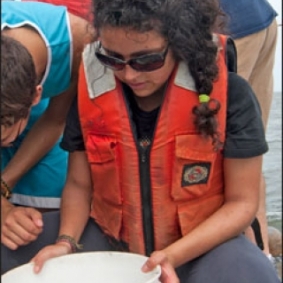Eight students will be presenting the summer work at the Ocean Sciences Meeting in March 2022!
Carolina Mendez, University of California, Berkeley
Class Year:
2012Mentor:
James Pierson, Ph.D.Project Title:
Effects of Hypoxia on Copepod Predation by the Ctenophore, Mnemiopsis leidyi, in Chesapeake Bay
Abstract:
The seasonal occurrence of low dissolved oxygen (DO) in Chesapeake Bay, caused by excess of nutrients and vertical stratification, affects most of the main deep channel of the estuary. Gelatinous zooplankton, such as the ctenophore Mnemiopsis leidyi, can switch the energy transfer in the food web from fish to jellies because some species are more tolerant to low dissolved oxygen concentrations than their prey and competitors. However, few studies have observed predation rates under different dissolved oxygen concentrations. We examined the gut content of the lobate ctenophores, M. leidyi and Beroe ovata, collected at two sites in the Chesapeake Bay with distinct DO concentrations. In addition, we performed a clearance rate experiment on M. leidyi feeding on brine shrimp Artemia salina, under saturated oxygen concentration. Our results indicate that at moderate low DO levels ctenophores are preying more on copepods than higher and anoxic DO levels. Early feeding experiments with A. salina suggest high ingestion and clearance rates of ctenophores. Understanding how gelatinous zooplankton change the energy transfer under low dissolved oxygen levels will enhance management tools could allow for better management of fisheries in the bay.
Location:
Horn Point LaboratoryPresentations:
Mendez, C.*, K. L. Liu, and J. J. Pierson. 2013. Effects of hypoxia on copepod predation by the ctenophore, Mnemiopsis leidyi, in Chesapeake Bay. ASLO Aquatic Sciences Meeting, New Orleans, Louisiana .




